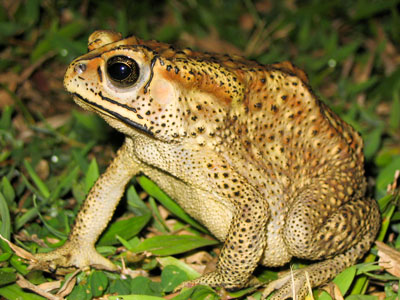The cane toad (Rhinella marina) is a large toad with the length reaching about nine inches for adults. They are mainly recognized by their U-shaped furrow between the eyes. Cane toad may grow to the size of a soccer ball. It is also known as ‘marine toad’ and the toad mainly occurs in the Central and South America including Mexico.
Cane Toad Facts
Anatomy
- Adult cane toads grow to a length of about 9 inches (230 mm) and weighs up to 3.3 lb (1.5 kg). Some of the large species such as Bufo paracnemis are nearly the size of a dinner plate.
- Female toads are larger than males with the weight averaging 10–15 cm (3.9–5.9 in).
- The heaviest specimen ever recorded at 2.65 kg (5.84) with the length reaching about 38 cm (15 in).
- They have got ridges around the eyes and the toad’s skin is reasonably dry.
- Cane toad shows an array of different colors including reddish brown, olive-brown, and yellowish grey.
Distribution & Habitat
- Marine toads are thought to occur in the South America, Central America, south of Texas, southeastern Peru, and Mexico.
- Unlike most other frogs, cane toads are found in the northern South America on both sides of the Andes.
- They are likely to make homes in habitats such as open areas, secondary forests, foothill, and lowland areas.
- Marine toads also occupy the wide tropical land of the northern Australia.

Behavior
- Cane toads breed in large numbers in rain. The breeding lasts about many months.
- They live near edges of lakes as well as permanent ponds.
- They are highly terrestrial animals and may only go into the freshwater for breeding.
- The skin of the marine toad is extremely toxic. When the toad is threatened it secretes a milky-white fluid called ‘bufotoxin’ that can even cause human death.
- The cane toad’s toxic skin is able to kill even the potential predators including skinks, goannas, snakes, and quolls. Since the introduction of cane toads in Australia, about 30% of the Australian terrestrial snakes are vulnerable.
- Studies show that the decline of Spotted-tailed Quoll’s population is primarily due to the arrival of the Marine toad. While adults pose threats to the land predators tadpoles are equally toxic to the aquatic predators.
- Cane toads are increasing in large numbers and the rate of increase is about 25 kilometers per year.
Feeding Ecology & Diet
- In the wild, cane toads are thought to rely on large roaches, arthropods, and ants. They mainly feed in areas that are around human populations.
- Cane toad’s diet also consists of rodents, birds, bats, amphibians, invertebrates, small reptiles, and plants.
- In urban areas, they will congregate in larger numbers especially under street lamps to eat insects.
- They may also consume foods of domestic cats and dogs.

Reproductive Biology
- During breeding season, cane toads produce extremely low-pitched trill that lasts about 10 – 20 seconds.
- A female toad is able to lay as many as 25,000 black eggs in one spawning. It lays eggs in the form of a string the length of which goes around 20 m (66 ft). Their eggs are found near ponds or swimming pools.
- Each of the eggs measure 1.7–2.0 mm (0.067–0.079 in) in diameter.
- Cane toad’s eggs hatch in about 2 days.
- In the wild, cane toads have a lifespan of 10 – 15 years while the captive animals survive up to 35 years.
- Baby toads are called tadpoles or toadlets and they average 10 to 25 mm (0.39 to 0.98 in) in length.
- Cane toads have got many natural predators in the wild such as water monitor, banded cat-eyed snake, killifish, rock flagtail, whistling kite, the black rat, Papuan frogmouth, meat ants, catfish, ibis, Australian crows, and bullet ants.






Leave a Reply